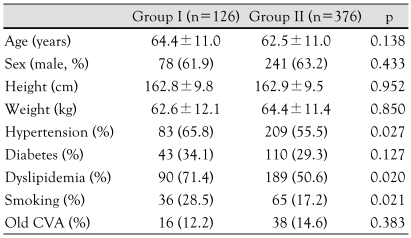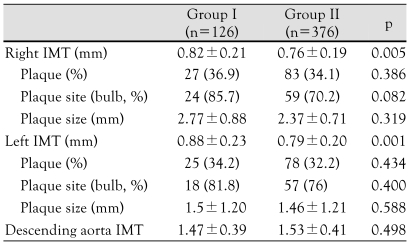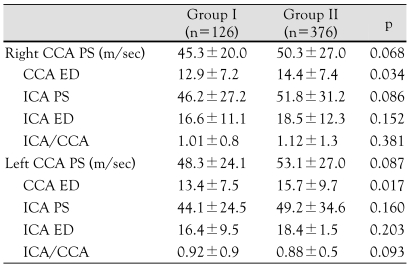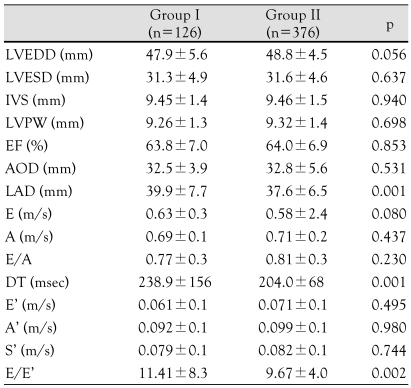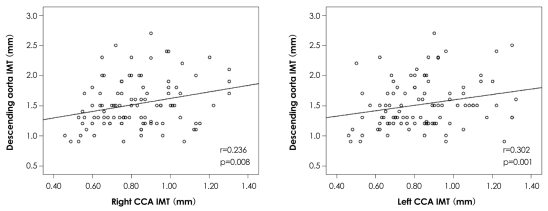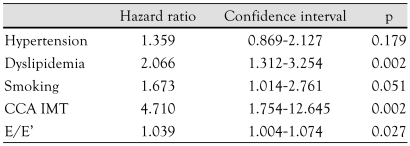Abstract
Background and Objectives
Carotid intima-media thickness (IMT) has been associated with an increased risk of ischemic stroke. To better understand this association, we evaluated the relationships of vascular risk factors, including carotid IMT and carotid plaque, and large territory cerebral infarction and small vessel stroke.
Subjects and Methods
A total of 502 patients with acute ischemic stroke were divided into two groups according to neurologic examinations and imaging studies; 1) a large territory infarction group (group I: n=126, 64.4±11 years, 78 males) and 2) a small vessel stroke group (group II: n=376, 62.5±11 years, 242 males). We evaluated associations between (a) territory and non-territory strokes and (b) age, sex, potential vascular risk factors, carotid image and cardiac function (by echocardiography).
Results
We did not find significant between group differences of age, sex, diabetes, previous history of ischemic stroke, plaque (presence, site and size of carotid plaque), and velocity of carotid blood flow and left ventricle ejection fraction. However, group I had a higher incidence of hypertension (p=0.006), smoking (p=0.003), and dyslipidemia (p=0.001). Group I had thicker carotid IMT than group II (right carotid: 0.81±0.21 mm vs. 0.76±0.19 mm, p=0.035; left carotid: 0.88±0.23 mm vs. 0.80±0.20 mm, p=0.014) and a higher e/e' level (12.08 vs. 9.66, p<0.001). Dyslipidemia, thicker carotid IMT and elevated E/E' ratios were significant independent predictors for large territory infarction in patients with ischemic stroke.
Conclusion
Carotid IMT is significantly increased in patients with large territory infarction compared with those with small vessel stroke.
Keywords: Cerebral infarction, Stroke, Carotid arteries
Introduction
The carotid arteries are responsible for providing blood flow to the brain. If the carotid artery is blocked, or if a piece of carotid artery plaque dislodges and travels to the brain, the individual can suffer a stroke. This can lead to paralysis, loss of ability to speak, blindness, loss of independence, and even death. Stroke is currently a leading cause of disability and the major leading cause of death in developing contries.1) A large portion of stroke cases result from cerebral ischemia; the remainder is from hemorrhage. Large territory cerebral infarction tends to be the result of ischemic insult more than small vessel lacunar infarction.
In earlier studies, carotid atherosclerosis was confirmed by autopsy or by angiography.2-5) However, over the last decade, the development of noninvasive ultrasound techniques has made the visualization and measurement of the layers of the arterial wall and plaques possible in large population samples.6-9) It has been suggested that the intima-media thickness (IMT) of the common carotid artery (CCA) is one of the most sensitive markers for the earliest stages of atherosclerosis.10)
Increases in carotid IMT have been associated with increased risk of ischemic stroke.11) We did this study to evaluate the relationship of vascular risk factors, including carotid IMT and carotid plaque, with large territory cerebral infarction, one of the common subtypes of ischemic stroke and small vessel stroke.
Subjects and Methods
Study population
A total of 502 patients with acute ischemic stroke were enrolled in our study between April 2007 to Septemter 2008.
Neurologists and radiologists diagnosed ischemic stroke by neurologic examination and imaging study. If patients had any embolic source such as infective endocarditis and intracardiac thrombi, they were excluded. Patients with ischemic stroke were divided into two groups according to infarct territory: Group I was defined by large territory infarctions (n=126, 64.4±11 years, 78 males). Group II was defined by small vessel strokes including lacunar infarction (n=376, 62.5±11 years, 242 males). We evaluated the association of territory and non-territory strokes with age, sex, potential vascular risk factors, carotid image and cardiac function (by echocardiography).
Definition of hypertension, diabetes, dyslipidemia and territory infarction
Subjects were considered to have hypertension if their blood pressure was ≥140/≥90 mmHg as recommended by the Joint National Committee (JNC) VII,12) or if they were on treatment for hypertension. The American Diabetes Association criteria13) were used to define diabetes mellitus (DM). We considered a subject to have DM when the fasting plasma glucose levels were ≥126 mg/dL in 2 consecutive assessments or if they were on treatment for DM. Dyslipidemia was diagnosed according to the 2004 update of National Cholesterol Education Program guidelines.14)
According to these guidelines, we included in the study patients with a level of low density lipoprotein-cholesterol ≥160 mg/d, a level of high density lipoprotein-cholesterol ≤40 mg/dL and a level of triglycerides ≥150 mg/dL.15) Large territory cerebral infarction was defined if a major cerebral artery territory infarction was shown by a neurologic examination and an imaging study. This included anterior, middle and posterior cerebral infarction. Lacunar, cortical or subcortical infarction were classified as small vessel stroke.
Laboratory tests
Blood sampling for serum lipid profiles and glucose were obtained after at least 14 hours of fasting.
Measurement of carotid intima-media thickness and carotid flow velocity
Carotid B-mode ultrasound was performed on both common carotid arteries and internal carotid arteries using a 10 MHz linear probe (VIVID 7, GE, USA). Images were interpreted at the last centimeter of the CCA prior to the carotid bulb. We first described the presence or absence of plaques or of atheromas, which were defined as a focal widening relative to adjacent segments protruding into the lumen more than 1.5 mm, with or without calcifications. On a longitudinal two-dimensional ultrasound image of the carotid artery, the anterior (near) and posterior (far) walls of the carotid artery appear as two bright white lines separated by a hypoechogenic space. End-diastolic images were frozen, and the far wall IMT was identified as the region between the lumen-intima interface and the media-adventitia interface.16) Peak systolic and end diastolic carotid flow velocity was measured by pulse wave Doppler on the CCA and the internal carotid artery (ICA).17)
Measurement of aortic intima-media thickness
Transesophageal echocardiography was done using an Acuson 128 XP or Sequoia C256 ultrasonograph (c, Mountain View, CA, USA) equipped with a 3.5- to 7.0-MHz multiplane probe. To ensure imaging of the entire thoracic aorta, the probe was rotated posteriorly and advanced to the distal esophagus and withdrawn slowly to scan the descending aorta and aortic arch. The probe was then rotated and advanced again to image the ascending aorta. The maximal value of the aortic IMT was collected for each patient.18) Transesophageal echocardiography was performed by experienced investigators who had no knowledge of the results of our other analyses.
Statistical analysis
Data are reported as mean±SD. In univariate analysis, risk factors for different end-points were analyzed using the Chi-square test for discrete variables and Student's t-test for continuous variables. Multiple logistic regression analysis was used to determine a model with independent predictive factors. A p<0.05 was considered statistically significant. The software for statistical analysis was Statistical Package for the Social Sciences 13.0.
Results
Baseline characteristics
We did not find any significant between group differences for age, sex, diabetes, or previous history of ischemic stroke. However, group I patients with large territory cerebral infarct had a significantly higher percentage of hypertension (p=0.006), smoking (p=0.003), and dyslipidemia (p=0.001) (Table 1). Also, group I had thicker carotid IMT values than did group II (right CCA: 0.81±0.21 mm vs. 0.76±0.19 mm, p=0.035; left CCA: 0.88±0.23 mm vs. 0.80±0.20 mm, p=0.014) despite the absence of significant differences between the two groups for the presence of carotid plaque, the site of carotid plaque, the size of carotid plaque and the velocity of carotid blood flow (Table 2 and 3). Regarding echocardiographic parameters, group I showed higher E/E' ratios-which indicate diastolic dysfunction-than did group II, whereas there was no significant between group difference for left ventricle ejection fraction, which indicates systolic dysfunction (Table 4).
Table 1.
Baseline clinical characteristics
CVA: cerebrovascular accident
Table 2.
Comparison of IMT and plaque in patients with ischemic stroke
IMT: intima-media thickness
Table 3.
Comparison of carotid blood flow velocity in the patients with ischemic stroke
CCA: common carotid artery, ICA: internal carotid artery, PS: peak systolic velocity, ED: end diastolic velocity
Table 4.
Comparison of echocardiographic parameters in patients with ischemic stroke
LVEDD: left ventricular end diastolic dimension, LVESD: left ventricular end systolic dimension, IVS: interventricular septal thickness, LVPW: left ventricular posterior wall thickness, EF: ejection fraction, AOD: aortic diameter, LAD: left atrial diameter, E: mitral inflow E velocity, A: mitral inflow A contraction velocity, DT: deceleration time, E': mitral septal annular velocity, A': mitral septal annulus A' velocity, S': mitral septal annulus systolic velocity
Correlation of carotid and aortic atherosclerosis
We found a positive and significant correlations between carotid IMT and descending thoracic aortic IMT (right CCA r=0.261, p=0.009; left CCA r=0.232, p=0.021) (Fig. 1). But, there were no significant correlations between descending thoracic aorta IMT and infarction territory. Descending thoracic aorta plaques were also not associated with infarct subgroup.
Fig. 1.
Correlation of descending thoracic aortic intima-media thickness (IMT) and common carotid artery (CCA) IMT.
Independent predictors of territory infarction
By multivariate regression analysis, dyslipidemia, thicker carotid IMT and elevated E/E' were significant independent predictors of large territory infarction in patients with ischemic stroke (Table 5).
Table 5.
Independent predictors of large territory infarction in patients with ischemic stroke
CCA: common carotid artery, IMT: intima-media thickness, E/E': mitral inflow E velocity/mitral septal annular velocity
Discussion
In this study, we compared CCA IMT and plaque for the risk assessment of respective stroke subtypes. Carotid IMT was significantly increased in patients with large territory infarction compare with those with small vessel stroke. Various noninvasive imaging has been recommended by the American Heart Association for evaluation of risk in primary prevention.19) Carotid IMT is well known as a noninvasive surrogate marker of coronary atherosclerosis. IMT is increased in patients who are at risk for cardiovascular disease and in those patients with atherosclerotic disease.20-23) O'Leary et al.24) reported that an increased carotid IMT is associated with a higher risk of stroke and acute myocardial infarction in an elderly population and it is also a more powerful predictor of cardiovascular disease than the conventional risk factors for atherosclerosis. Similarly, Touboul et al.25) demonstrated a greater CCA IMT in patients with all major cerebral infarction subtypes compared with controls. In contrast, Nagai et al.26) reported a greater plaque score only for atherothrombotic and lacunar infarction patients compared to nonstroke patients. Consequently, the implications of carotid atherosclerosis remain to be established for each stroke subtype.
Certain known risk factors exist for the development of carotid artery atherosclerosis. These include smoking, diabetes, high blood pressure, high cholesterol, family history of cardiac or vascular disease and advanced age. The present results indicated that hypertension, smoking and dyslipidemia are more common in patients with large territory cerebral infarct.
Some previous investigators reported that carotid plaque was superior to carotid IMT for stratification of cardiovascular risk, and that carotid IMT was not a significant predictor for myocardial infarction and stroke.27),28) However, carotid IMT was different from carotid plaque as a predictor for developing stroke subtypes in this study. Also, IMT of the descending thoracic aorta showed a strong correlation with coronary atherosclerosis and was a good predictor for stroke and peripheral arterial disease in some reports.29) In our study, descending thoracic aorta IMT was correlated with carotid IMT as in the previous study, whereas they did not find a significant correlation with infarction subtype. Therefore, we thought that the atherosclerosis of the descending thoracic aorta was related to ischemic stroke, but this variable did not differentiate infarct subtype. Based on our findings, carotid IMT evaluation was more sensitive than other surrogate markers such as carotid plaque or descending aorta IMT for differentiating stroke subtypes in patients with ischemic stroke.
Additionally, diastolic dysfunction was more common in patients with large territory cerebral infarcts. Many investigators insist that diastolic dysfunction is not a disease but a step of the aging process resulting from decreasing left ventricle compliance.30),31) Left ventricular systolic function tends to be preserved compared with diastolic function until old age. Although age differences were not significant between groups, the large territory infarction group showed higher E/E' than did the small vessel infarction group. This finding suggests a large infarction effect on diastolic function rather than on systolic function in patients with ischemic stroke.
The current study has several limitations, both in the diagnosis of stroke subtypes and in the transferability of conclusions to the general population. Because this study had a cross-sectional designed, whether it can be applied to all individuals with stroke is not clear. Large prospective studies are still necessary to establish a link between these measures and future risk of stroke subtypes.
Acknowledgments
This study was supported by a grant from the Korea Healthcare technology R&D project (A084869), Ministry for Health, Welfare & Family Affairs, Republic of Korea, and the Cardiovascular Research Foundation, Asia.
References
- 1.Wolf PA, D'Agostino RB. Epidemiology of stroke. In: Barnett HJ, Mohr JP, Stein BM, Yatsu FM, editors. Stroke. 3rd ed. New York: Churchill Livingstone; 1998. pp. 3–28. [Google Scholar]
- 2.Young W, Gofman JW, Tandy R, Malamud N, Waters ES. The quantitation of atherosclerosis: III. the extent of correlation of degrees of atherosclerosis within and between the coronary and cerebral vascular beds. Am J Cardiol. 1960;6:300–308. doi: 10.1016/0002-9149(60)90318-0. [DOI] [PubMed] [Google Scholar]
- 3.Mitchell JR, Schwartz CJ. Relationship between arterial disease in different sites: a study of the aorta and coronary, carotid and iliac arteries. Br Med J. 1962;1:1293–1301. doi: 10.1136/bmj.1.5288.1293. [DOI] [PMC free article] [PubMed] [Google Scholar]
- 4.Solberg LA, Eggen DA. Localization and sequence of development of atherosclerotic lesions in the carotid and vertebral arteries. Circulation. 1971;43:711–724. doi: 10.1161/01.cir.43.5.711. [DOI] [PubMed] [Google Scholar]
- 5.Hertzer NR, Young JR, Bevan EG, et al. Coronary angiography in 506 patients with extracranial cerebrovascular disease. Arch Intern Med. 1985;145:849–852. [PubMed] [Google Scholar]
- 6.Handa N, Masayasu M, Hiroaki M, et al. Ultrasound evaluation of early carotid atherosclerosis. Stroke. 1990;21:1567–1572. doi: 10.1161/01.str.21.11.1567. [DOI] [PubMed] [Google Scholar]
- 7.Geroulakos G, O'Gorman DJ, Kalodiki E, Sheridan DJ, Nicolaides AN. The carotid intima-media thickness as a marker of the presence of severe asymptomatic coronary artery disease. Eur Heart J. 1994;15:781–785. doi: 10.1093/oxfordjournals.eurheartj.a060585. [DOI] [PubMed] [Google Scholar]
- 8.Gnasso A, Irace C, Mattioli PL, Pujia A. Carotid intima-media thickness and coronary heart disease risk factors. Atherosclerosis. 1996;119:7–15. doi: 10.1016/0021-9150(95)05625-4. [DOI] [PubMed] [Google Scholar]
- 9.Lorenz MW, Kegler S, Steinmetz H, Markus HS, Sitzer M. Carotid intima-media thickening indicates a higher vascular risk across a wide age range: prospective data from the carotid atherosclerosis progression study (CAPS) Stroke. 2006;37:87–92. doi: 10.1161/01.STR.0000196964.24024.ea. [DOI] [PubMed] [Google Scholar]
- 10.Howard G, Sharrett AR, Heiss G, et al. Carotid artery intima-media thickness distribution in general populations as evaluated by B-mode ultrasound. Stroke. 1993;24:1297–1304. doi: 10.1161/01.str.24.9.1297. [DOI] [PubMed] [Google Scholar]
- 11.Salonen R, Seppanen K, Rauramaa R, Salonen JT. Prevalence of carotid atherosclerosis and serum cholesterol levels in eastern Finland. Arteriosclerosis. 1988;8:788–792. doi: 10.1161/01.atv.8.6.788. [DOI] [PubMed] [Google Scholar]
- 12.Chobanian AV, Bakris GL, Black HR, et al. The Seventh Report of the Joint National Committee on Prevention, Detection, Evaluation, and Treatment of High Blood Pressure: the JNC 7 Report. JAMA. 2003;289:2560–2572. doi: 10.1001/jama.289.19.2560. [DOI] [PubMed] [Google Scholar]
- 13.Expert Committee on the Diagnosis and the Classification of Diabetes Mellitus. Report of the expert committee on the diagnosis and the classification of diabetes mellitus. Diabetes Care. 1997;20:1183–1197. doi: 10.2337/diacare.20.7.1183. [DOI] [PubMed] [Google Scholar]
- 14.Grundy SM, Cleeman JI, Merz CN, et al. Implications of recent clinical trials for the National Cholesterol Education Program Adult Treatment Panel III guidelines. Circulation. 2004;110:227–239. doi: 10.1161/01.CIR.0000133317.49796.0E. [DOI] [PubMed] [Google Scholar]
- 15.Hatzitoliosa AI, Athyrosb VG, Karagiannisb A, et al. Implementation of strategy for the management of overt dyslipidemia: the IMPROVE-dyslipidemia study. Int J Cardiol. 2009;134:322–329. doi: 10.1016/j.ijcard.2009.02.001. [DOI] [PubMed] [Google Scholar]
- 16.Park KR, Kim KY, Yoon SM, Bae JH, Seong IW. Correlation between intima-media thickness in carotid artery and the extent of coronary atherosclerosis. Korean Circ J. 2003;33:401–408. [Google Scholar]
- 17.Withers CE, Gosink BB, Keightley AM, et al. Duplex carotid sonography: peak systolic velocity in quantifying internal carotid artery stenosis. J Ultrasound Med. 1990;9:345–349. doi: 10.7863/jum.1990.9.6.345. [DOI] [PubMed] [Google Scholar]
- 18.Bae JH, Bassenge E, Park KR, Kim KY, Schwemmer M. Significance of the intima-media thickness of the thoracic aorta in patients with coronary atherosclerosis. Clin Cardiol. 2003;26:574–578. doi: 10.1002/clc.4960261206. [DOI] [PMC free article] [PubMed] [Google Scholar]
- 19.Smith SC, Jr, Greenland P, Grundy SM. Prevention conference: V. beyond secondary prevention: identifying the high-risk patient for primary prevention. Circulation. 2000;101:111–116. doi: 10.1161/01.cir.101.1.111. [DOI] [PubMed] [Google Scholar]
- 20.Grobbee DE, Bots ML. Carotid artery intima-media thickness as an indicator of generalized atherosclerosis. J Intern Med. 1994;236:567–573. doi: 10.1111/j.1365-2796.1994.tb00847.x. [DOI] [PubMed] [Google Scholar]
- 21.Pignoli P, Tremoli E, Poli A, Oreste P, Paoletti R. Intimal plus medial thickness of the arterial wall: a direct measurement with ultrasound imaging. Circulation. 1986;74:1399–1406. doi: 10.1161/01.cir.74.6.1399. [DOI] [PubMed] [Google Scholar]
- 22.Hulthe J, Wikstrand J, Emanuelsson H, Wiklund O, de Feyter PJ, Wendelhag I. Atherosclerotic changes in the carotid artery bulb as measured by B-mode ultrasound are associated with the extent of coronary atherosclerosis. Stroke. 1997;28:1189–1194. doi: 10.1161/01.str.28.6.1189. [DOI] [PubMed] [Google Scholar]
- 23.Bae JH, Seung KB, Jung HO, et al. Analysis of Korean carotid intima-media thickness in Korean healthy subjects and patients with risk factors: Korea multi-center epidemiological study. Korean Circ J. 2005;35:513–524. [Google Scholar]
- 24.O'Leary DH, Polak JF, Kronmal RA, et al. Thickening of the carotid wall: a marker for atherosclerosis in the elderly? Stroke. 1996;27:224–231. doi: 10.1161/01.str.27.2.224. [DOI] [PubMed] [Google Scholar]
- 25.Touboul PJ, Elbaz A, Koller C, et al. Common carotid artery intima-media thickness and brain infarction. Circulation. 2000;102:313–318. doi: 10.1161/01.cir.102.3.313. [DOI] [PubMed] [Google Scholar]
- 26.Nagai Y, Kitagawa K, Sakaguchi M, et al. Significance of earlier carotid atherosclerosis for stroke subtypes. Stroke. 2001;32:1780–1785. doi: 10.1161/01.str.32.8.1780. [DOI] [PubMed] [Google Scholar]
- 27.Ebrahim S, Papacosta O, Whincup P, et al. Carotid plaque, intima-media thickness, cardiovascular risk factors, and prevalent cardiovascular disease in men and women: the British Regional Heart Study. Stroke. 1999;30:841–850. doi: 10.1161/01.str.30.4.841. [DOI] [PubMed] [Google Scholar]
- 28.Bots ML, Hoes AW, Koudstaal PJ, Hofman A, Gobbee DE. Common carotid intima-media thickness and risk of stroke and myocardial infarction: the Rotterdam Study. Circulation. 1997;96:1432–1437. doi: 10.1161/01.cir.96.5.1432. [DOI] [PubMed] [Google Scholar]
- 29.Yoon HJ, Hyun DW, Kwon TG, Kim KH, Bae JH. Prognostic significance of descending thoracic aorta intima-media thickness in patients with coronary atherosclerosis. Korean Circ J. 2007;37:365–372. [Google Scholar]
- 30.Masugata H, Senda S, Yoshikawa K, et al. Relationships between echocardiographic findings, pulse wave velocity, and carotid atherosclerosis in type 2 diabetic patients. Hypertens Res. 2005;28:965–971. doi: 10.1291/hypres.28.965. [DOI] [PubMed] [Google Scholar]
- 31.Salmasi A, Alimo A, Jepson E, Dancy M. Age-associated changes in left ventricular diastolic function are related to increasing left ventricular mass. Am J Hypertens. 2003;16:473–477. doi: 10.1016/s0895-7061(03)00846-x. [DOI] [PubMed] [Google Scholar]



